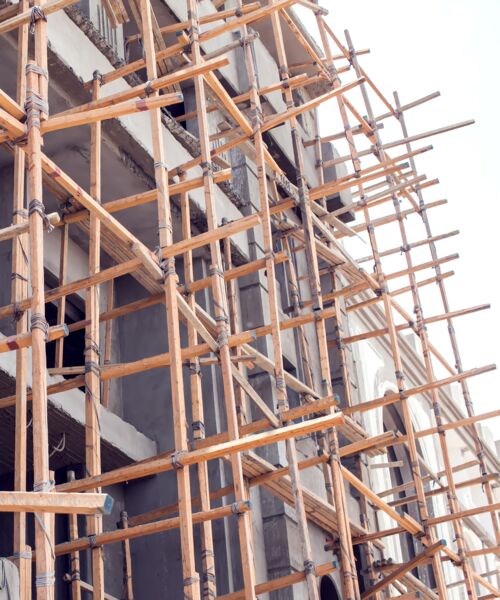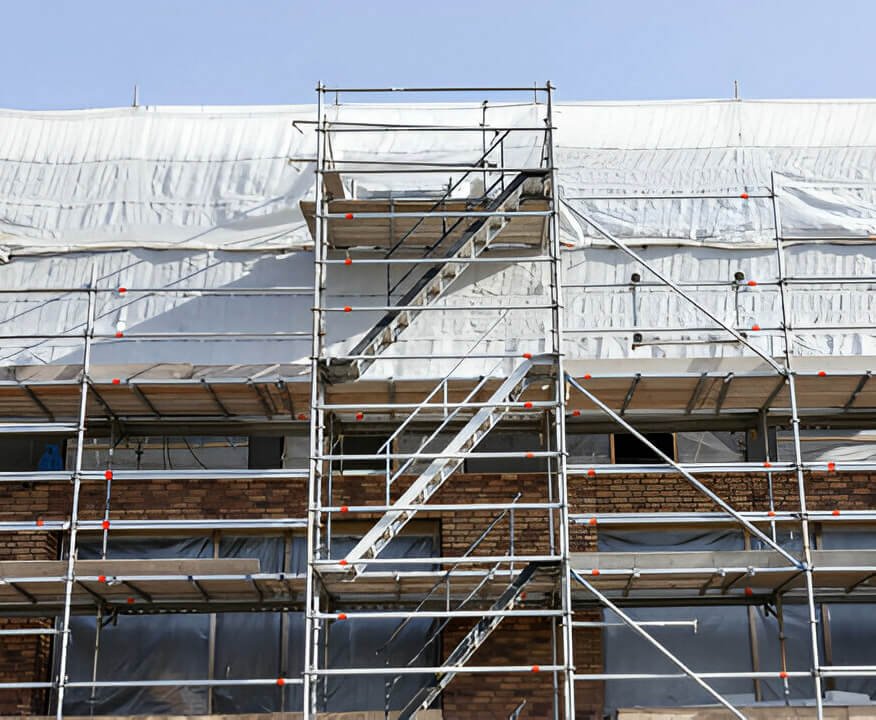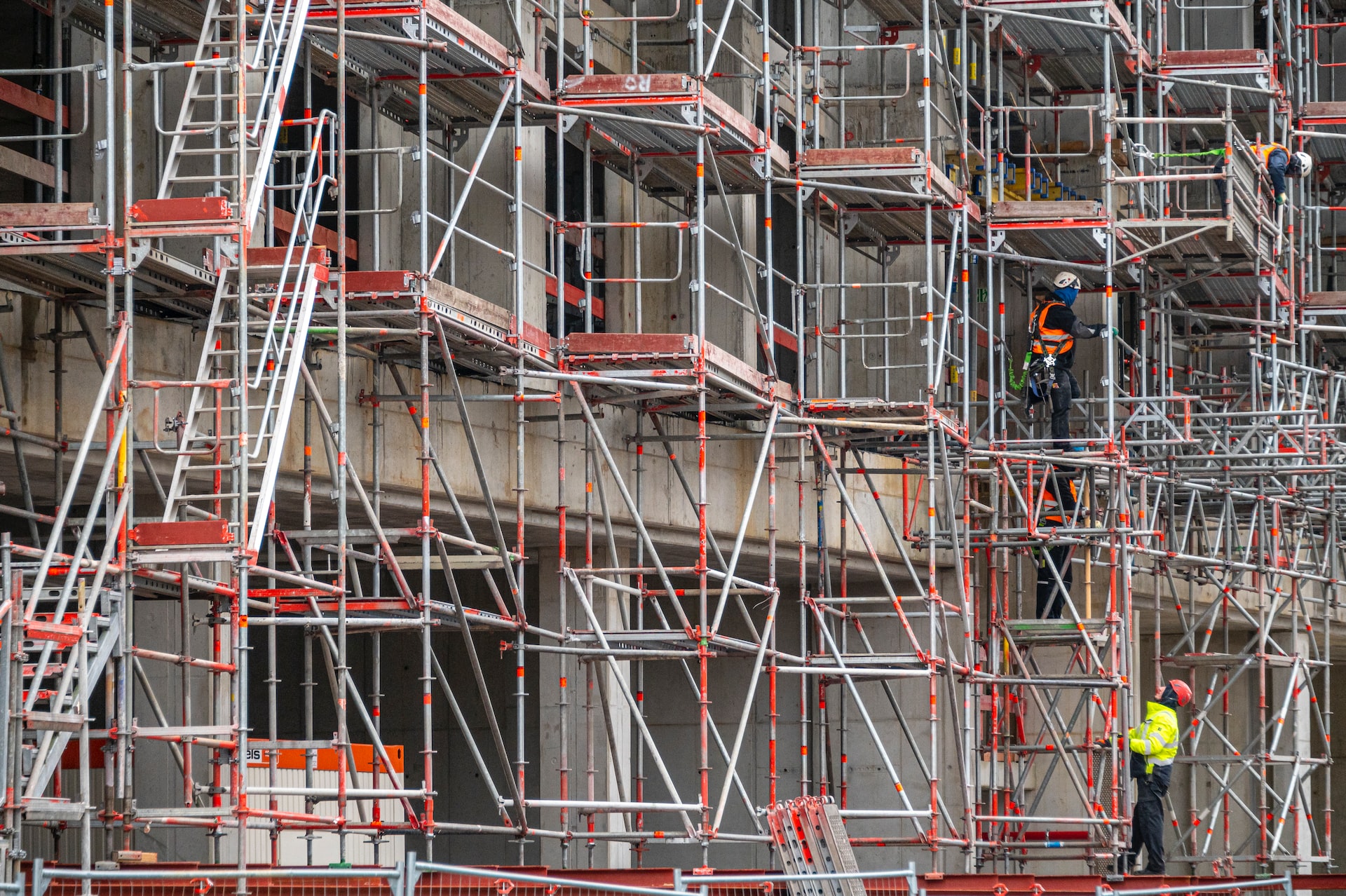Temporary Roof Scaffolding for Your Construction or Renovation Project
Temporary Roof Scaffolding for Your Construction or Renovation Project
Blog Article
A Comprehensive Overview to the Crucial Attributes of Scaffolding in Modern Construction
The landscape of contemporary building and construction progressively depends on reliable scaffolding systems that focus on innovation, effectiveness, and safety and security. As jobs expand in complexity, comprehending the vital attributes of scaffolding becomes essential for guaranteeing worker safety and security and enhancing job timelines. This overview checks out different kinds of scaffolding, highlights crucial safety functions, and checks out material improvements that contribute to efficiency and sustainability. The ramifications of these elements extend much beyond plain construction techniques, motivating a better look at exactly how they affect total job success and employee wellness.
Sorts Of Scaffolding
Although scaffolding systems can differ commonly in design and application, they generally come under several distinct categories that provide to different construction demands - Scaffolding. One of the most typical kinds include sustained scaffolding, put on hold scaffolding, and rolling scaffolding
Sustained scaffolding includes systems supported by a framework of posts, which give a elevated and stable functioning surface. This kind is normally made use of for tasks that require substantial altitude, such as bricklaying or exterior painting.
Put on hold scaffolding, alternatively, is utilized for jobs needing accessibility to high altitudes, such as cleaning or repairing structure facades. This system hangs from a roof or one more structure, permitting employees to reduced or increase the platform as needed.
Moving scaffolding attributes wheels that enable for easy flexibility across a job website. It is particularly valuable for tasks that call for constant moving, such as indoor operate in big areas.
Each kind of scaffolding is created with certain applications in mind, guaranteeing that building and construction tasks can be performed efficiently and successfully. Understanding these categories is critical for choosing the ideal scaffolding system to meet both task requirements and website problems.
Key Security Functions
Safety and security is vital in scaffolding systems, as the potential dangers connected with functioning at elevations can lead to major crashes otherwise appropriately managed. Key safety attributes are necessary to ensure the well-being of employees and the integrity of the building and construction site.
Most importantly, guardrails are important. These barriers offer a physical protect versus drops, considerably lowering the danger of major injuries. Furthermore, toe boards are frequently used to stop tools and materials from dropping off the scaffold, shielding employees below.
Another vital element is the use of non-slip surface areas on systems. This function boosts grasp, particularly in unfavorable climate conditions, thus lessening the likelihood of drops and slips. Gain access to ladders should be securely positioned to help with risk-free entrance and leave from the scaffold.
Normal examinations and upkeep of scaffolding systems are likewise essential. These evaluations ensure that all parts remain in great condition and functioning appropriately, resolving any wear or damages without delay.
Finally, appropriate training for all workers included in scaffolding procedures is essential to guarantee that they understand security procedures and can identify possible threats. Scaffolding. Collectively, these features create a safer working setting and dramatically mitigate dangers connected with scaffolding
Product Innovations
Developments in material scientific research have significantly affected the scaffolding industry, boosting both safety and security and effectiveness in modern-day construction. The intro of high-strength steel and light weight aluminum alloys has actually reinvented traditional scaffolding systems. These products are not just lighter, making them easier to deliver and assemble, however additionally provide superior load-bearing abilities. This results in scaffolding structures that can support higher weights while decreasing the risk of collapse.
In addition, ingenious composite products, such as fiberglass-reinforced plastics, have become viable choices. These products are resistant to rust and environmental destruction, hence prolonging the lifespan of scaffolding systems, especially in rough climate condition. Using such materials adds to reduce maintenance prices and makes certain regular efficiency in time.


Layout Considerations
Thinking about the complexities of modern-day building and construction projects, efficient scaffolding layout is vital to guaranteeing both functionality and safety and security. Design considerations must encompass various aspects, consisting of load capability, height, and the certain needs of the building and best site construction site. Each task offers one-of-a-kind challenges, requiring a versatile method to scaffolding systems that can adjust to varying conditions.
Architectural integrity is vital; as a result, engineers need to compute the tons that the scaffolding will certainly support, including employees, materials, and devices. The choice of materials plays a vital duty in guaranteeing the scaffolding can endure these lots while staying light-weight and durable. Furthermore, the style needs to enable for very easy access and egress, assisting in the smooth activity of employees and products.
Safety and security features, such as guardrails and non-slip surface areas, should be included to decrease dangers of mishaps. In addition, the format has to take into consideration the surrounding setting, including nearby structures and possible hazards. By addressing these layout factors to consider, building and construction firms can boost the performance of scaffolding systems and advertise a much safer working atmosphere, eventually adding to the general success of the project.
Upkeep and Assessments
The performance of scaffolding systems prolongs past preliminary layout and execution; recurring maintenance and normal assessments are essential to guaranteeing their proceeded performance and safety throughout the period of a task. Routine examinations need to be conducted by qualified personnel to determine any signs of wear, damage, or instability that can jeopardize the stability of the scaffolding.
Upkeep protocols must consist of routine checks of architectural components, such as slabs, frameworks, and installations, ensuring that all elements stay safe and secure and totally free from rust or various other damage. In addition, the functionality of safety and security attributes, such as get more guardrails and toe boards, must be analyzed to ensure conformity with safety policies.
Paperwork of all assessments and maintenance tasks is important for liability and governing conformity. A methodical method to record-keeping not only aids in tracking the problem of the scaffolding yet likewise offers essential evidence in case of an incident.
Eventually, establishing a comprehensive upkeep and examination schedule will substantially decrease the danger of crashes and improve the general security of the building and construction website. By prioritizing these methods, building and construction managers can secure employees and promote the task's stability.

Conclusion
In final thought, the necessary attributes of scaffolding in contemporary why not find out more construction encompass a variety of crucial components, consisting of varied kinds, key safety mechanisms, material advancements, and thoughtful layout considerations. Emphasizing security via guardrails and non-slip surfaces, along with advancements in materials like high-strength steel, improves both efficiency and sustainability. Regular upkeep and assessments are crucial for making sure architectural honesty and safety on building and construction sites, eventually helping with efficient project execution and promoting the well-being of workers.
The landscape of modern-day building significantly depends on efficient scaffolding systems that prioritize efficiency, advancement, and security.Innovations in material scientific research have actually considerably affected the scaffolding sector, boosting both safety and security and efficiency in contemporary building. Generally, these product innovations not just improve the performance and security of scaffolding systems yet additionally line up with the sector's push towards sustainability, as several modern-day materials are created to be much more eco friendly.
Taking into consideration the complexities of contemporary construction tasks, effective scaffolding design is paramount to making sure both functionality and safety.In verdict, the important features of scaffolding in modern-day building incorporate a range of critical aspects, consisting of varied types, essential safety devices, product innovations, and thoughtful design factors to consider.
Report this page